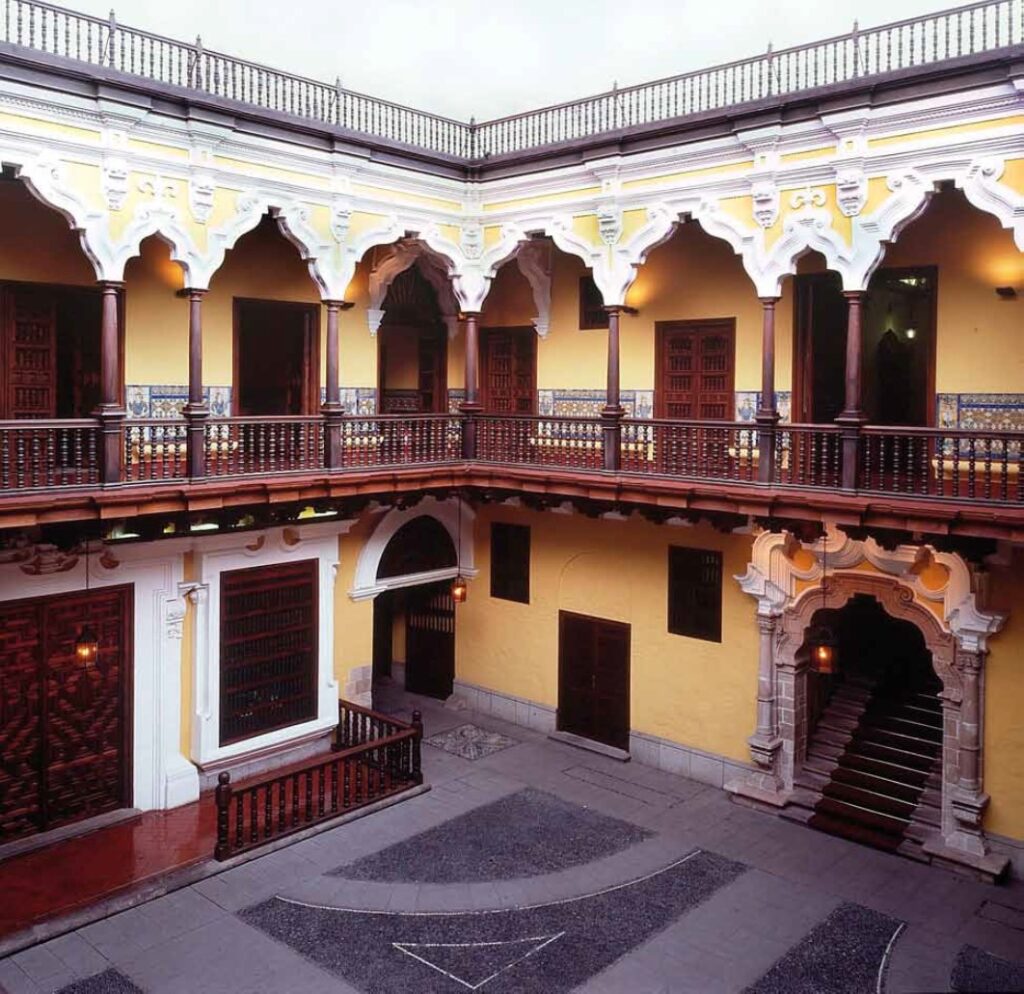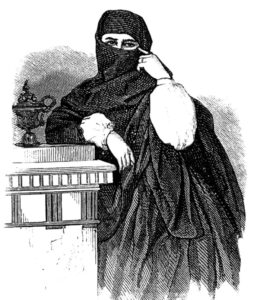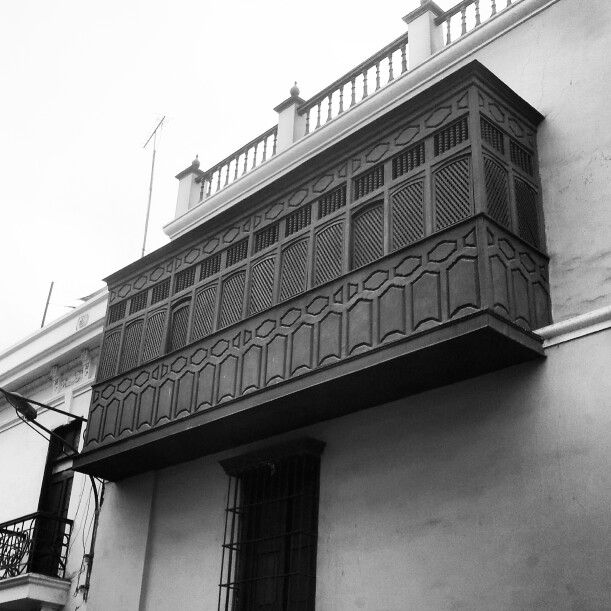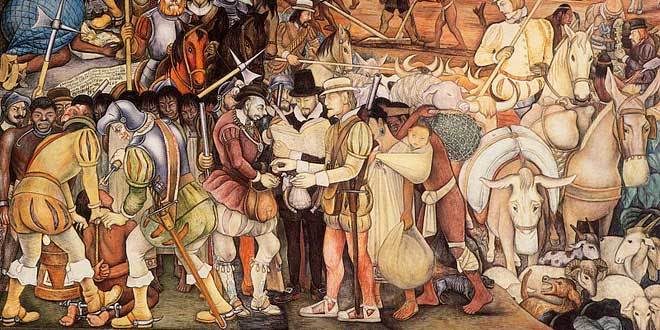Articles
Muslims in the Viceroyalty of Peru
Article author: Nelson Manrique
Date of publication of the article: 23/02/2022
Year of publication: 2022
Article theme: Arabic, Architecture, History, Islam.
To speak on the subject of the Arabs in the viceroyalty, it would be necessary to situate the context of what happens with Spain and the Arabs around the period of the conquest of America.
I would like to recall briefly that 1492, when America was discovered, was the same year in which the Catholic Monarchs took Granada, the last Muslim stronghold in Spain, on January 1.
Spain is unified under Christian hegemony, the inhabitants of Granada are left with a special status, as Muslims in a process of conversion to Christianity. It is interesting that the conversion strategies used in Granada -as demonstrated in an investigation by Antonio Garrido Aranda- are used as a model for evangelization strategies in America and vice versa.
In 1570 there was a Moorish uprising in the Alpujarras, territories in the mountains of Granada, and in 1609 the Crown decided to expel the Moors. The last of them leave the Iberian Peninsula in 1614. They are the inhabitants of Ricote.

Now, expelling the Jews, first, and the Muslims, later, seeks to build a homogeneous Spain, which rejects everything that is different. If you go to live in Spain during those centuries, you have to be a Catholic, under penalty of being burned at the stake if you try to circumvent this provision. The fundamental function of the Inquisition was to persecute apostasy.
So, those Jews and Muslims who convert to Catholicism are watched by the Inquisition, and if they are found to be Judaizing or Islamizing, this institution punishes them, and they can even end up at the stake.
There are several investigations that show the presence of hundreds of thousands of Jews who converted to Christianity. They were known as “new Christians”, and later many were discovered to be Judaizing, among other things because in many cases the conversion was forced (they became Christians to save their lives when crowds of fanatical Christians invaded their aljamas to massacre those who refused to be baptized).
Some crypto-Jews, or marranos, as they were known, escaped to America; they fled from the vigilance of the Inquisition. Several of them were burned in Lima. However, there is only one case of a person burned by the Inquisition for Islamizing, according to Ricardo Palma’s Los anales de la Inquisición (The Annals of the Inquisition). The great paradox is also that this Muslim was a Frenchman, held captive for several years in Turkish territory, who converted to Islam. He was discovered Islamizing in Lima and ended up at the stake.
The first issue I would like to highlight is that, if we are going to find an Arab presence in the viceroyalty, it is not a legal presence. By definition, a Muslim Arab was excluded in the Peruvian viceroyalty, as were Jews.
This did not prevent the arrival of Arabs, of Muslims, which are different things, as any Arab knows clearly. That is to say, one can be a Muslim without the need to be an Arab. Muslim encompasses something much broader, the community of believers who follow the teachings of Mohammed on a global scale.
Despite restrictions and controls, the dynastic alliance between Portugal and Spain allowed for a period, from 1560 to 1640, the entry of Jews and Muslims, disguised under another identity, to the viceroyalty.
There is very little information about these people, except for one investigated case, of which Dr. Del Busto Duthurburu knows, without a doubt, that of Emir Cigala, who lived under the identity of Gregorio Zapata, became captain of the king’s armies, was in Potosi, made his fortune and, only when he returned to his homeland, revealed his identity, Emir Cigala, Turk.
It would be necessary to say, then, that the Arab presence is very reduced in the viceroyalty, but I believe that it would be necessary to raise the question of if being Arab is a biological fact or a cultural fact.
If we stop at the biological data, the Arab presence, not only in the Peruvian viceroyalty, but in the Iberian Peninsula itself is relatively small. The host that conquered Spain in 711 was formed, by the way, by people that came from the Arabian peninsula, but that brought with them a whole set of ethnic groups that were folding to the Muslim armies as the Islam was conquering the whole North of Africa.
It is a whole set of ethnic groups that entered Spain in the 8th century. There are Arabs from the Arabian Peninsula no doubt, as there are also Iranians, to speak anachronistically. I am referring to the current territories of Iran and Iraq. There are also people from North Africa, both Egyptians and also from the current territory of Morocco and Algeria, the territory then known as Barbary, the land of the Berbers.
Islamic heritage in the Iberian Peninsula and America

To measure the impact of the Arab in the Peruvian viceroyalty, it is necessary to understand its influence in the Iberian Peninsula. There is an interesting indicator, which is language.
We know that Castilian descends from Latin. From the 10th century onwards, Latin split into groups of vulgar languages known as Romance languages and from these emerged Castilian.
Modern Spanish has the greatest contribution, on this Latin base, of terms taken directly from the Arabic language. More than four thousand terms of modern Spanish are taken directly from Arabic.
In comparison, the second most important language, in its influence on Castilian, is the Germanic language, brought to the peninsula by the Visigoths. It contributes something like seven hundred terms. Y
if we compare both influences, in the Germanic languages most of the terms are basically patronymics and toponyms, names of people and places; while the terms taken from Arabic come from all human experience: arts, sciences, agriculture, mining, navigation, astronomy, philosophy; all the disciplines and all the spiritual expressions of the peoples.
What is the reason for this enormous impact of the Arabic on the Iberian Peninsula? In recent years there have been several investigations that radically change the image that Spain was a nation taken by the Arabs from its settlers in 711 and that the Spaniards fought for eight centuries to recover their lost territory. Spain did not exist in 711 to begin with. It was a collection of fragmented, splintered kingdoms, at odds with each other, conquered by an army made up of a host of diverse ethnic groups.
During the Middle Ages it was normal in ancient Hispania (which Muslims knew as al-Andalus) for Christian princes to ally with Muslim emirs to fight against other Christians, and vice versa, for Muslim emirs to ally with Christian princes to fight against other Muslim emirs. In other words, the border was not religious.
Secondly, current research shows that, of the Muslim population in Spain in the 12th century, only one-fifth was descended from foreigners, Arabs and North Africans; and four-fifths were former Christians or descendants of these former Christians, converted to Islam.

How to understand this enormous magnitude of the conversion of Christians who ended up converting to Islam? On the one hand, it was the fact that Christianity was going through a series of religious conflicts, there were many dissident currents in the Iberian Peninsula, and this weakened the Christian front.
Secondly, the Muslim expansion was extraordinary. In seventy years – from 632 to the end of the 7th century – it reached the Atlantic to the west; and India and China to the west, thanks to its political regime, which was astonishingly tolerant.
The conquering Muslim armies imposed no more taxes than those usually paid by the inhabitants of the territories they conquered to the kingdoms to which they depended. They allowed them to preserve their language, their culture, their laws, their authorities. The two conditions that the conquered had to fulfill were to recognize the superiority of Islam, that is to say, submission, without the need to convert, and, secondly, to pay the tribute that financed the expansion of Islam, of the territory of Islam: to give Islam the territory of the believers.
The Arab culture was splendorous, comparatively with the barbaric feudal Europe, after the enormous cultural decadence that followed the end of the Roman Empire. This led to a massive conversion of Christians in the Iberian Peninsula. First, by convenience in the dominant sectors; and then by dazzlement by the Muslim culture.
The ambassador of Otto the Great, a Germanic prince who goes to Granada in the 12th century, to describe this city, can only use, as an element of comparison, the fabulous Baghdad. Why? Because the people in Iberia dress in the Arab style, they speak “algarabía“. Algarabía comes from al’arabbiya, the Arabic language, a mixture of Romance languages and Arabic.
The inhabitants of the peninsula live, eat, dress in the Arabic style, speak a language that is a mixture of Romance languages with Arabic, algarabía, al’arabbiya.
Mudejar heritage after the conquest of America
After the conquest of America, James Lockartt is struck by the fact that Muslims or descendants of Muslims arrive in America, in a very modest status. Of the people who were in Cajamarca, there was only one person, Cristóbal de Burgos, of whom there is mention that he was reputed to be a Moor, although there is no confirmation that he was indeed a Moor. It is necessary to specify that the Moors are the ex-Muslims converted to Christianity, while the Muslims who remained as such in Hispania, under the Christian domination, were known as Mudejars.
In what condition do the rest of the Moriscos arrive? Basically as slaves. It is interesting to note the gender ratio among the slaves. The slaves that arrive in America are of two types: those coming from black Africa. In this case, for every two or three men comes a woman; and it is because what is wanted is physical strength, unskilled workers for rough labor, and Moorish slaves, among whom the proportion between the genders is the reverse, for every male comes four or five women.
Why this difference? Because, among the Moorish slaves, the males are specialized craftsmen. The very terms “albañil” and “alarife” are Arabic. The term Mudejar – as we have already said – originally designated in the Iberian Peninsula the Muslim who lived under Christian domination, but remained Muslim. Hence the name “Mudejar” is given to the art mentioned by Dr. Del Busto Duthurburu, which is going to have such an impact on craftsmanship, art and colonial architecture.
These Moorish artisans, masons and masons will imprint the genius of Arab art on the culture of Spanish America, but what about the women? Why this enormous proportion of women? To use Lockartt’s terms, when a Spaniard says he is “bringing a black slave” it can be presumed that he is bringing her as a sexual companion, but when he brings a Moorish slave, she is undoubtedly a concubine. The bulk of Moorish women who arrive in America do so as slaves, fulfilling a dual function of housekeeper and concubine. They arrived in a rather modest situation. To a great extent, the presence they acquired in the viceroyalty had to do with the fortune, or the little fortune, of the partner to whom they were attached.

As opposed to the indigenous population, these second-generation Moorish women were eventually assimilated and became full Spaniards. Their presence, if one looks at the situation today, can still be found in those territories of America and Peru, where the aristocratic groups have been rather inbred. I am thinking, for example, of Trujillo, where Moorish traits are still characteristic.
So from this assimilation of the Moorish slaves converted, as opposed to the indigenous, into Spaniards, this Arab heritage is going to spread over the whole of what is the viceroyalty society.
A presence denied, but with a great strength, which is still denied today, but which greatly enriches our cultural heritage, which makes us a country of all bloods and all homelands on a scale that is just beginning to be known.
Excerpted from La huella árabe en el Perú. Leyla Bartet and Farid Kahhat (comp). Fondo Editorial del Congreso del Perú, 2010. 257 pp.
Source: Chasqui. El Correo de Perú


